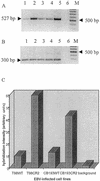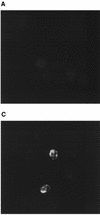Epstein-Barr virus infection of human astrocyte cell lines
- PMID: 10438862
- PMCID: PMC104299
- DOI: 10.1128/JVI.73.9.7722-7733.1999
Epstein-Barr virus infection of human astrocyte cell lines
Abstract
Epstein-Barr virus (EBV) is implicated in different central nervous system syndromes. The major cellular receptor for EBV, complement receptor type 2 (CR2) (CD21), is expressed by different astrocyte cell lines and human fetal astrocytes, suggesting their susceptibility to EBV infection. We demonstrated the infection of two astrocyte cell lines, T98 and CB193, at low levels. As infection was mediated by CR2, we used two stable CR2 transfectant astrocyte cell lines (T98CR2 and CB193CR2) to achieve a more efficient infection. We have monitored EBV gene expression for 2 months and observed the transient infection of T98 and T98CR2 cells and persistent infection of CB193 and CB193CR2 cells. The detection of BZLF1, BALF2, and BcLF1 mRNA expression suggests that the lytic cycle is initiated at early time points postinfection. At later time points the pattern of mRNA expressed (EBER1, EBNA1, EBNA2, and LMP1) differs from latency type III in the absence of LMP2A transcription and in the expression of BALF2 and BcLF1 but not BZLF1. A reactivation of the lytic cycle was achieved in CB193CR2 cells by the addition of phorbol esters. These studies identify astrocyte cell lines as targets for EBV infection and suggest that this infection might play a role in the pathology of EBV in the brain.
Figures








Similar articles
-
Stable transfection of Epstein-Barr virus (EBV) nuclear antigen 2 in lymphoma cells containing the EBV P3HR1 genome induces expression of B-cell activation molecules CD21 and CD23.J Virol. 1990 Mar;64(3):1002-13. doi: 10.1128/JVI.64.3.1002-1013.1990. J Virol. 1990. PMID: 2154588 Free PMC article.
-
Detection of heterogeneous Epstein-Barr virus gene expression patterns within individual post-transplantation lymphoproliferative disorders.Am J Pathol. 1995 Oct;147(4):923-33. Am J Pathol. 1995. PMID: 7573368 Free PMC article.
-
Heterogeneous, restricted patterns of Epstein-Barr virus (EBV) latent gene expression in patients with chronic active EBV infection.J Gen Virol. 2001 Oct;82(Pt 10):2385-2392. doi: 10.1099/0022-1317-82-10-2385. J Gen Virol. 2001. PMID: 11562532
-
Epstein-Barr virus latency in blood mononuclear cells: analysis of viral gene transcription during primary infection and in the carrier state.J Virol. 1994 Nov;68(11):7374-85. doi: 10.1128/JVI.68.11.7374-7385.1994. J Virol. 1994. PMID: 7933121 Free PMC article.
-
Nasal NK- and T-cell lymphomas share the same type of Epstein-Barr virus latency as nasopharyngeal carcinoma and Hodgkin's disease.Int J Cancer. 1996 Nov 4;68(3):285-90. doi: 10.1002/(SICI)1097-0215(19961104)68:3<285::AID-IJC3>3.0.CO;2-Y. Int J Cancer. 1996. PMID: 8903467
Cited by
-
Epstein-Barr Virus in Gliomas: Cause, Association, or Artifact?Front Oncol. 2018 Apr 20;8:123. doi: 10.3389/fonc.2018.00123. eCollection 2018. Front Oncol. 2018. PMID: 29732319 Free PMC article. Review.
-
Radiation-induced upregulation of telomerase activity escapes PI3-kinase inhibition in two malignant glioma cell lines.Int J Oncol. 2013 Aug;43(2):375-82. doi: 10.3892/ijo.2013.1970. Epub 2013 May 31. Int J Oncol. 2013. PMID: 23727752 Free PMC article.
-
Unraveling the links between neurodegeneration and Epstein-Barr virus-mediated cell cycle dysregulation.Curr Res Neurobiol. 2022 Jun 30;3:100046. doi: 10.1016/j.crneur.2022.100046. eCollection 2022. Curr Res Neurobiol. 2022. PMID: 36685766 Free PMC article. Review.
-
Epstein-Barr Virus dUTPase Induces Neuroinflammatory Mediators: Implications for Myalgic Encephalomyelitis/Chronic Fatigue Syndrome.Clin Ther. 2019 May;41(5):848-863. doi: 10.1016/j.clinthera.2019.04.009. Epub 2019 Apr 28. Clin Ther. 2019. PMID: 31040055 Free PMC article.
-
Epstein-Barr virus and multiple sclerosis: moving from questions of association to questions of mechanism.Clin Transl Immunology. 2023 May 17;12(5):e1451. doi: 10.1002/cti2.1451. eCollection 2023. Clin Transl Immunology. 2023. PMID: 37206956 Free PMC article. Review.
References
-
- Ahearn J M, Fearon D T. Structure and function of the complement receptors, CR1 (CD35) and CR2 (CD21) Adv Immunol. 1989;46:183–219. - PubMed
-
- Alfieri C, Birkenbach M, Kieff E. Early events in Epstein-Barr virus infection of human B lymphocytes. Virology. 1991;181:595–608. - PubMed
-
- Bagasra O, Lavi E, Bobroski L, Khalili K, Pestaner J P, Tawadros R, Pomerantz R J. Cellular reservoirs of HIV-1 in the central nervous system of infected individuals: identification by the combination of in situ polymerase chain reaction and immunohistochemistry. AIDS. 1996;10:573–585. - PubMed
-
- Bray P F, Culp K W, McFarlin D E, Panitch H S, Torkelson R D, Schlight J P. Demyelinating disease after neurologically complicated primary Epstein-Barr virus infection. Neurology. 1992;42:278–282. - PubMed
Publication types
MeSH terms
Substances
LinkOut - more resources
Full Text Sources
Research Materials

